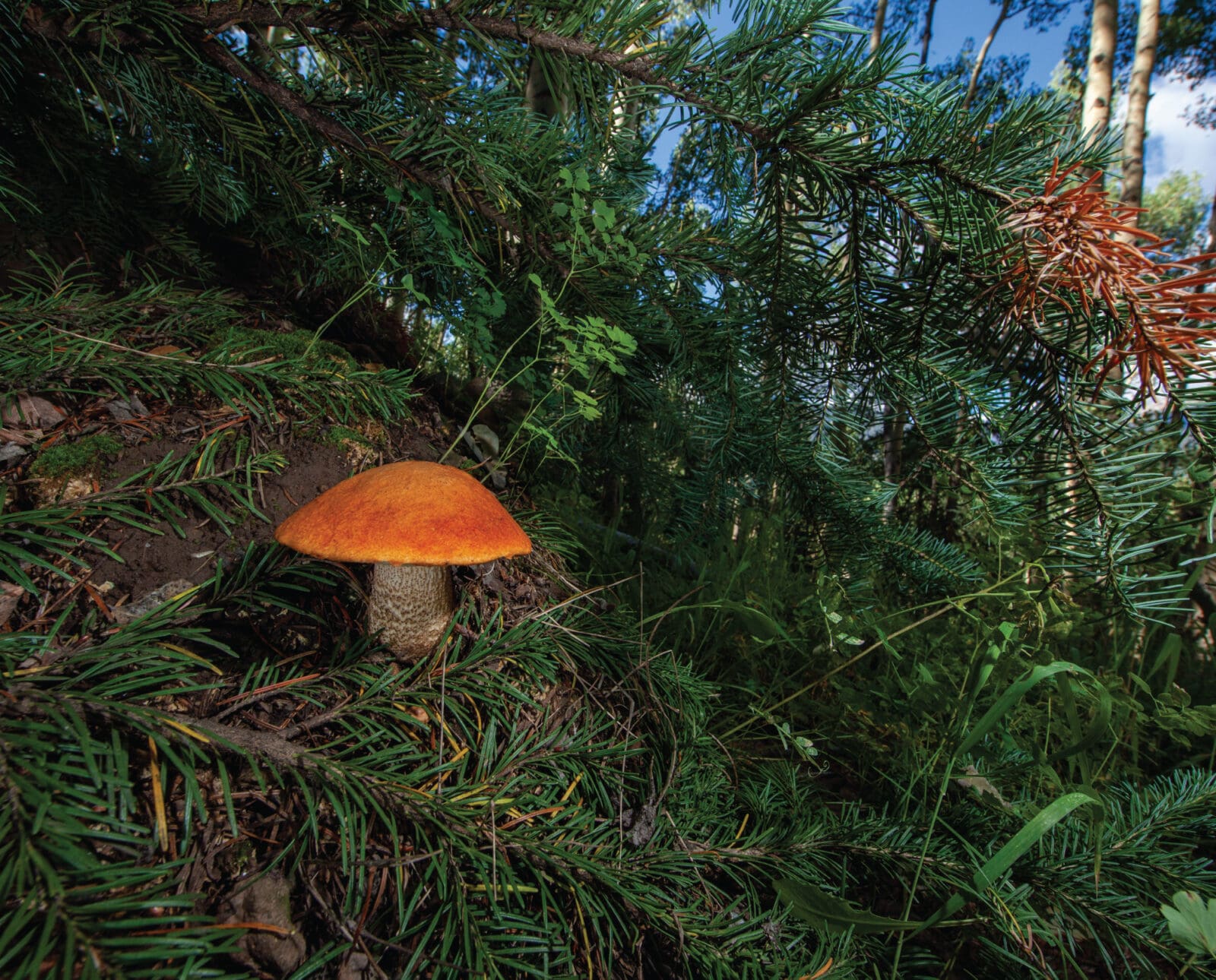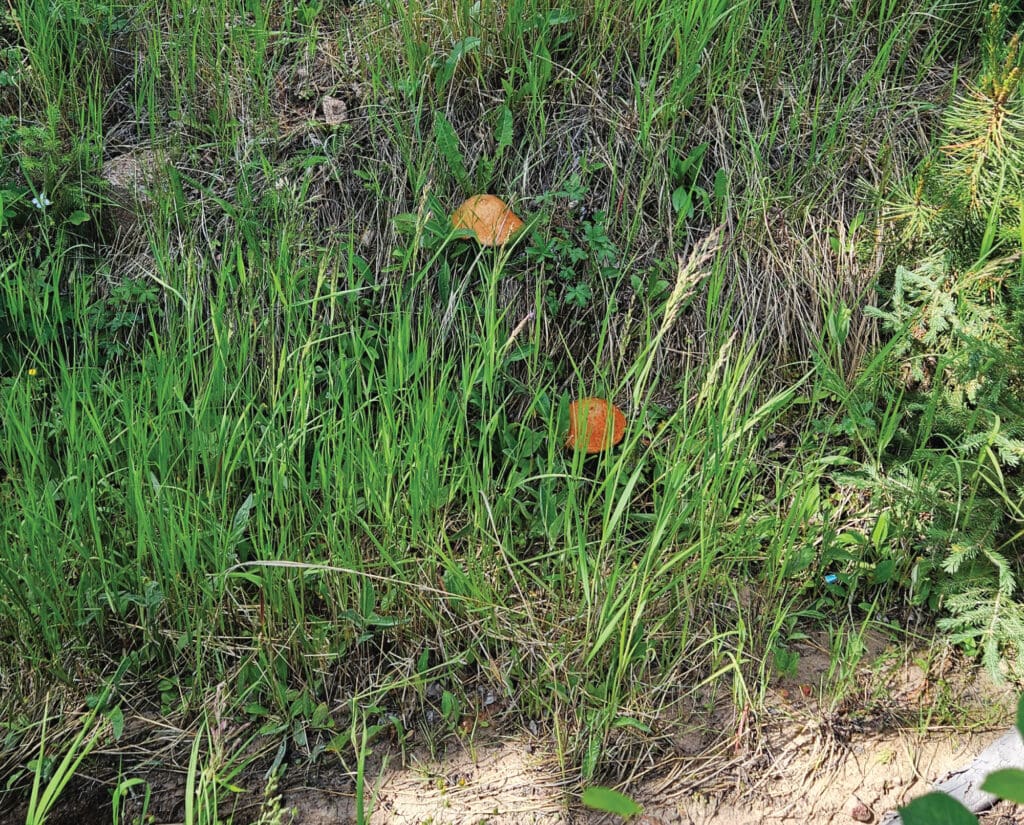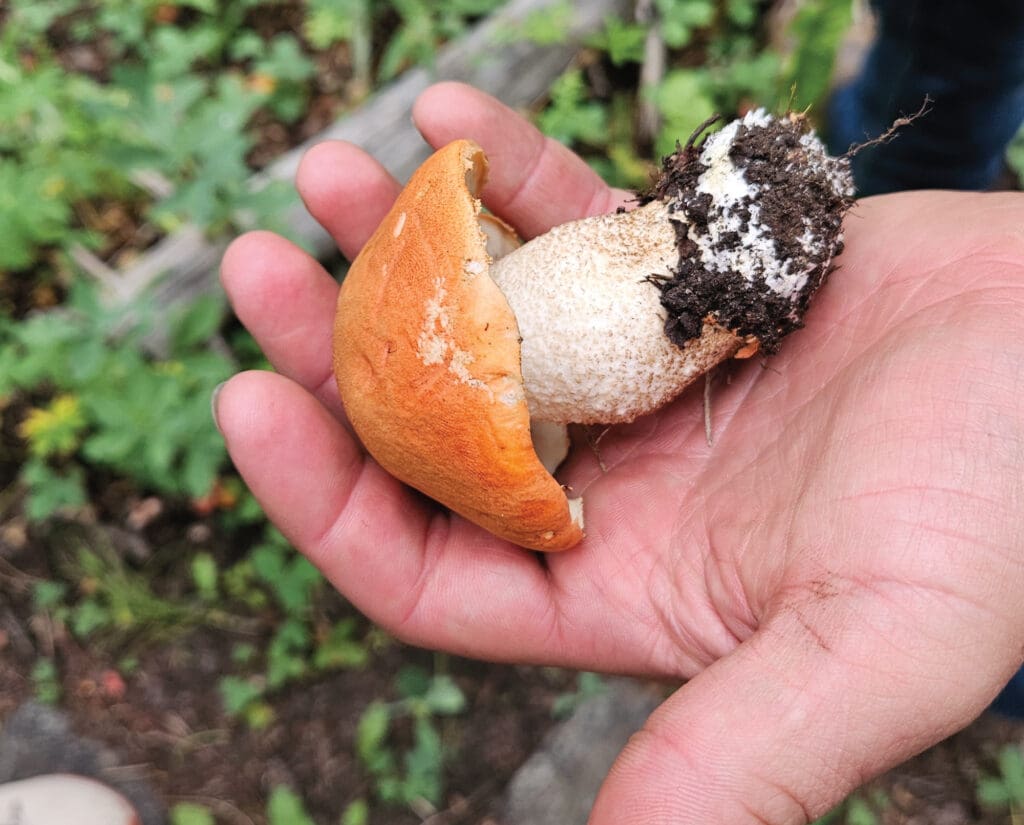Home » Foraging » Identifying and Foraging Aspen Bolete Mushrooms
Identifying and Foraging Aspen Bolete Mushrooms

Melissa An is a Colorado native originally from Colorado Springs…
How to locate, pick, and prepare aspen boletes for the dinner table
May marks the beginning of the foraging season. This time of year, I stalk the weather forecast, looking for rainy days, and start checking my spots’ in search of delicious morsels scattered along the forest ground. I’m talking about boletes, but more specifically, aspen boletes!
Also referred to as leccinums or birch boletes, this abundant mushroom can be found throughout the United States and very easily spotted in my home state of Colorado. I honestly find these mushrooms the most when I’m not foraging for them at all.
Aspen boletes are identifiable by their bright orangish and sometimes browner tops and scaly stalks. The stalks are always covered in short, projecting brownish-black scales or scabers. The stalk can be a little fat, similar to king boletes, or pretty skinny, but it should always have scabers. Another key feature of these mushrooms is their ability to turn a bluish color after being picked or sustaining damage. Don’t let this deter you from trying this mushroom out.
They can grow just about anywhere in any environment, ranging from marshes to arid, rocky areas. Aspen boletes will almost always appear in mixes of conifers and aspens, but especially near aspens and birch trees as per their name. I’ve found them in various elevations, starting as low as 7,000 feet all the way up to 10,000 feet. They’ll grow throughout the summer and sometimes even in the early days of fall. They are a hefty, hardy mushroom and usually resist bugs. Their spongy underside keeps the bugs separated from the delicious tops.

Foraging for Aspen Bolete Mushrooms
When foraging boletes, I’ve always plucked them. However, it’s always a good idea to have a knife on you to check the stalk for bugs and trim up any inedible edges. The stalk is almost always visible and can easily be snapped; I can remove most of the mushroom without disturbing the mycelium. Snapping the mushroom off at the base also lets me see if any bugs have made their way into it.
Before I pluck any bolete mushroom, I give it a couple of taps on its cap. I do this to listen to the denseness of the mushroom and help spread spores before plucking. However, I won’t pluck it if the mushroom doesn’t sound dense. From experience, this means a very buggy mushroom.
When considering the size of each forageable mushroom, the larger it is, the more likely it’s much older and lacks flavor. This doesn’t mean older mushrooms are not worth picking. However, if you want the best texture and flavor, the smaller ones are best. Aim for mushrooms about the size of your palm. In addition to being cute, the flavor of button mushrooms is more potent, and the thick texture is way more enjoyable than older mushrooms’ fluffy textures.

Preparing Aspen Boletes for Consumption
There has been a lot of talk about aspen boletes and whether or not they are poisonous. By definition, they are not poisonous, but they can cause gastric issues in some people. These gastric issues come in many severity levels. Usually, the problems relate to the amount of mushrooms consumed. I have never become ill myself from these mushrooms, and I’ve never had anyone I’ve fed these mushrooms experience any ill side effects. Preparing and cooking time is the primary key to properly consuming aspen boletes.
After you’ve brought home your mushrooms from a successful forage, fill your sink or a large tub with water and give the mushrooms a good soak. They will become a little slimy when wet, so using gloves can help you keep your grip. This is an initial rinse and will soften the dirt and debris that is stuck on the mushrooms. I remember my family huddling around the large tub and cleaning each mushroom as we chatted. Watching the bugs crawl out from the submerged mushrooms as a kid was always very fascinating.
After inspecting and cleaning each mushroom, they go into another tub of clean water for a final rinse. Then, it’s time to cut and prepare them for storage. This process was so much fun when I was younger. The adults would slice the mushrooms while the kids lay them out on large tarps to dry in the sun. Now, we use dehydrators, but seeing those large patches of drying mushrooms in your backyard was always a sight to see.
After cleaning your mushrooms, slice them into manageable sizes, remove the spongy underside, and lay them on paper towels to dry. You can eat them immediately, dehydrate them, or freeze them for future meals.
Before eating aspen boletes, I highly recommend dry sauteing the mushrooms beforehand. The heat eliminates any mild toxins in edible mushrooms that could make you sick. Dry sauteing also enhances the overall flavor of the mushroom, as some boletes can sometimes be described as having a bland or mild flavor. Dry sauteing also allows them to absorb the flavors in your overall dish. When cooking these mushrooms, cook them for long periods before serving. These should turn a dark color. If you plan on dehydrating your aspen boletes, dry sauteing isn’t required; you’ve essentially done the same act while dehydrating them.
My favorite way to enjoy these mushrooms (after dry sauteing) is to fry them up with some sesame oil and butter for about 20 minutes or until they turn a rich, dark color. Season with simple salt and pepper, and enjoy on a bed of rice with some seaweed. However, you can get pretty creative with these mushrooms. They make a great main or side dish, accompanying meat dishes or mimicking them for vegetarians. A good rule of thumb is that if you are trying a mushroom for the very first time, taste test with a very small quantity first and wait for the results. If you don’t have any symptoms within 30 minutes after consuming, you should be good to eat more.
There are a large variety of bolete mushrooms out there. Aspen boletes have their share of horror stories, but I hope you now have the confidence to explore your hunting grounds and taste palette for boletes.
Melissa An is a Colorado native originally from Colorado Springs but now resides in the mountains of Golden. Melissa is an engineer who was raised as a forager starting at a very young age and hunted a variety of mountain vegetables with her family. She currently focuses on guiding with Uncharted Outdoorswomen and off-roading with 4GXCruisers!



